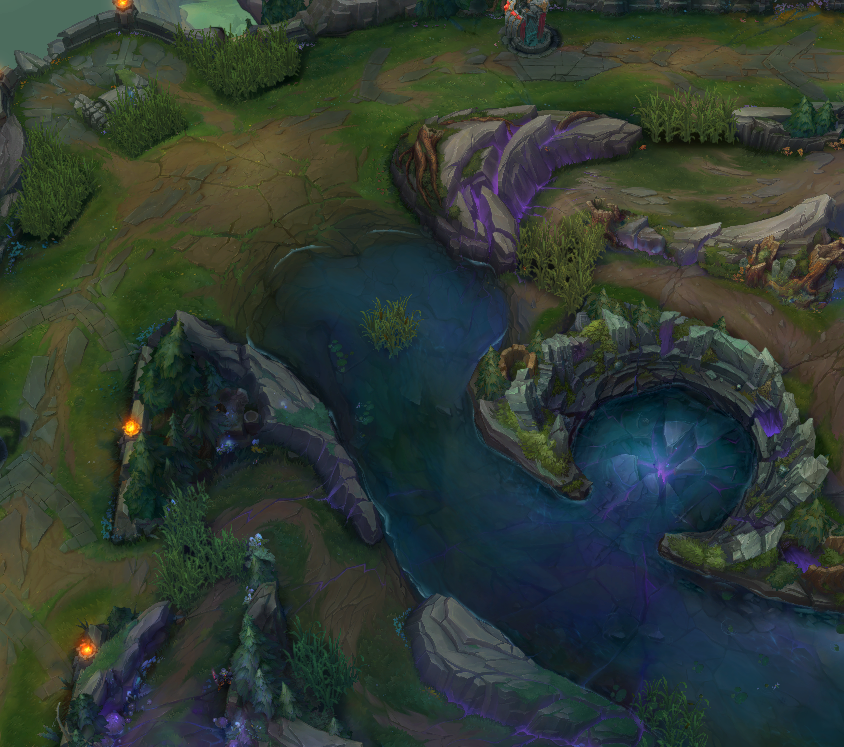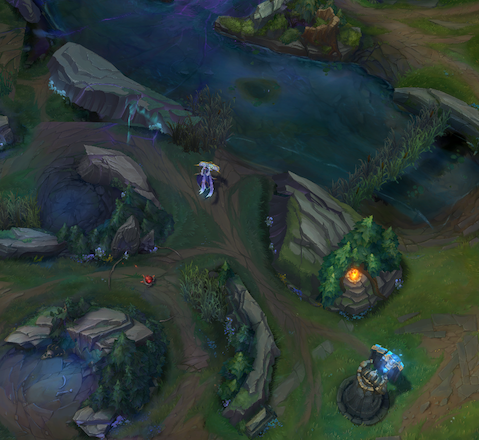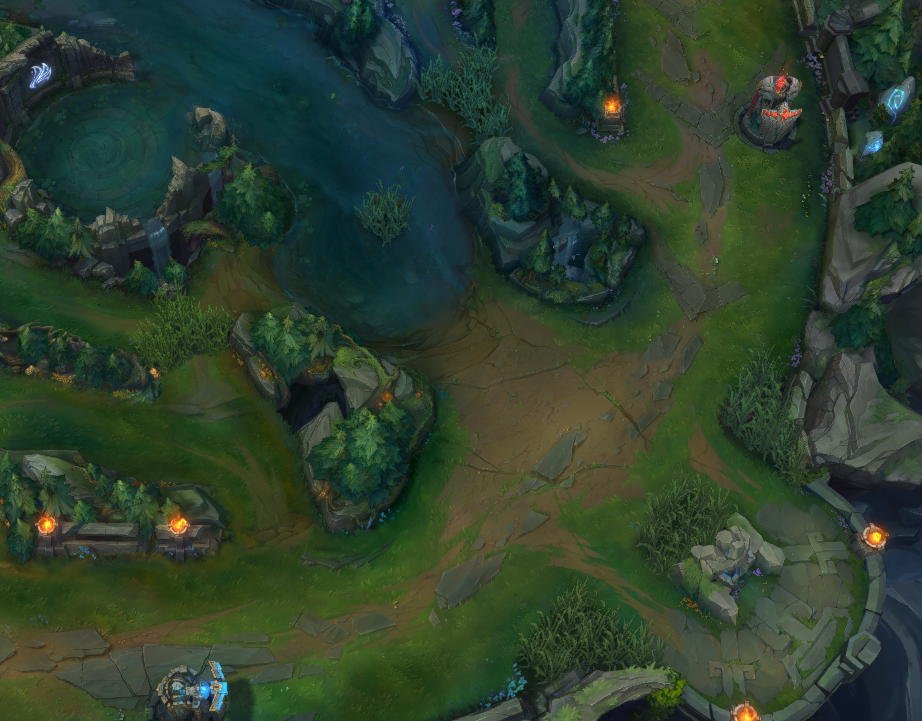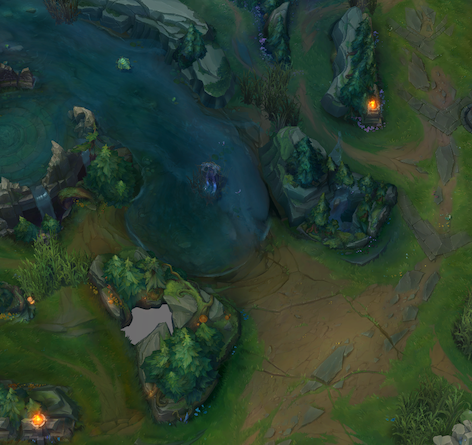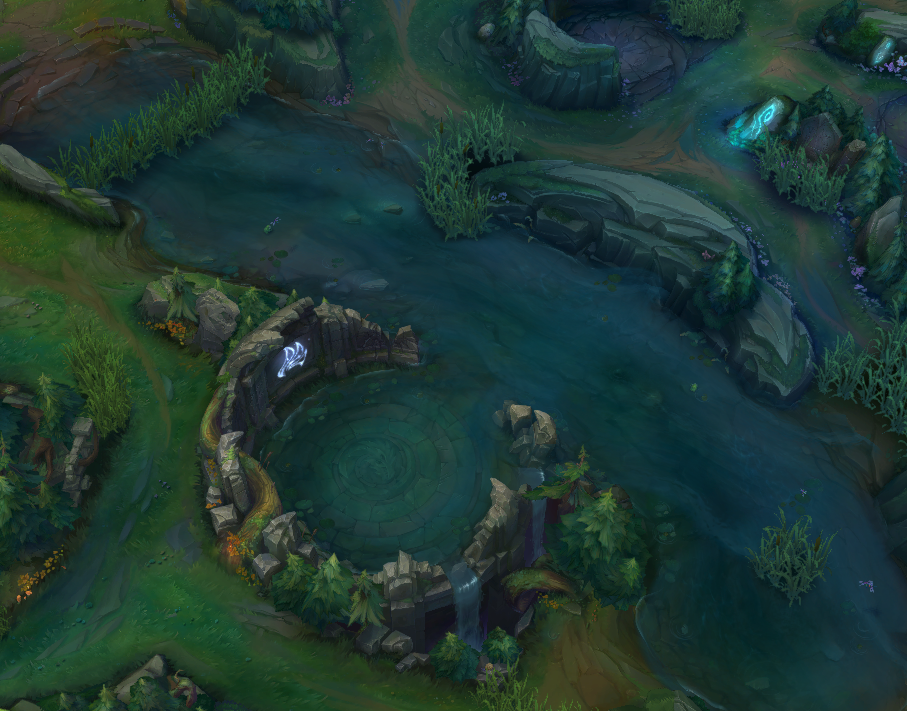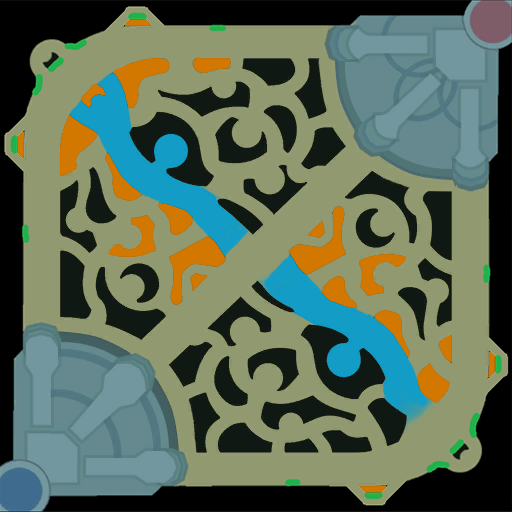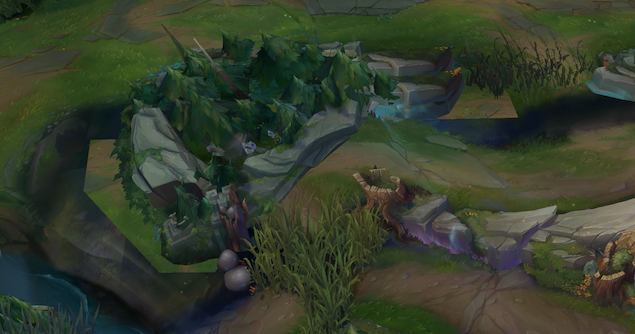/dev: Season 2024 Map Changes
The League base map hasn’t changed at all since, what, 2019? And in a bigger way, all the way back in 2014? It’s a great map, don’t get me wrong, but it’s definitely got some problems that have gotten more noticeable as players have learned to play it at a deep and comfortable level. We’re not here to solve every problem with the map, and we’re also not here to say we’re not making new problems for the map (some will certainly crop up!). No map is perfect.
Ch-Ch-Ch-Ch-Changes
We’ve got a few different goals with the map changes this season. At the highest level, our goal is to make lanes more fair across sides. Red and blue sides have very different advantages in a lane with respect to how to gank them, how fights play out, how you can posture against the brush or river, etc. These differences will still exist, but in lesser ways. For example, top lane red side won’t feel nearly so exposed when pushing up, so you don’t need to be a safer laner to exist when the champ select gods put you red side.
The second goal of the map changes was specifically around making solo lanes a bit more protected from the junglers, or roamers generally. Ganking as a primary early game output was just too strong in most cases. Each lane had a slightly different reason for their changes however. Let’s dive into those now.
Top-sy Turvy
Top lane is in a constant push and pull between players wanting more influence and output over the rest of the map in the lane, and also being substantially less influenced by the other roles, especially early on. For most players, the lane simultaneously feels entirely at the mercy of your jungler (or roaming support in higher skill levels) and also unable to do anything to win the game except with major leads.
We’re substantially reducing the ability for other lanes to affect top in the early game, letting the 1v1 fight really shine. It’s not like the jungler won’t be able to gank at all, so still watch out. We’re also shifting top brush into a pixel in the center of the river so it’s less side-skewed and substantially more powerful when contested. It tends to be correct to ward outside of the river brush on live in many cases and while this still remains true to an extent, this brush is closer to an optimal warding position and is less potent for ganking than before.
Also, an extension of the jungler influence on top lane was early Rift Herald. More often than not, Rift Herald was dropped in top lane (it’s closest to her lair after all), and she absolutely destroys any laning phase that might exist. What’s a tower to a crab god? Shelly regularly invalidated laning phases by destroying towers and adding giant influxes of gold to a specific laner, usually entirely at the jungler’s whim. We’ve seen that quite often both top laners are dissatisfied with lanes breaking apart this early—the behind player being put into the dumpster, and the ahead player not having any more time to play with their lead. By pushing back Rift Herald, we’re intending to substantially reduce the volatility of the late laning phase top lane experience. Dovetailing off the objective space, one of our goals with the new Voidgrubs objective is that top laners will have a lot more agency in affecting the outcome of the early top side objective than before. We’re also making the top side objective more potent for team-wide success than previously so that their early leads can matter more for the team. We’ll go more into the Voidgrubs in this other article, but overall we’re aiming to give top laners a lane more protected from outside influence while making their lane more important for the team’s overall chances of victory.
Making Mid Less Mid
Mid lane was a similar set of changes for some slightly different goals. It is the lane (on live) with by far the most access for ganking, and one thing we’ve noticed is that over the years players have learned just how unsafe the lane is for a lot of our more immobile champions without great self-peel. The Zyras and Brands and Karthuses of League have felt like the midlane was no longer able to be their home as more and more high-agency characters appeared and junglers learned just how easy it was to punish these immobile mages.
Our main goal here was to make mid substantially safer for this class of characters at a fundamental level. Opening up midlane to be mage-forward should give us a real role for this class again. The goal is not at all to push assassins out of this lane, just make it more hospitable for immobile characters with respect to their ability to face junglers. They’re still definitely gankable, but should be a bit less so than they are currently.
The other main change for mid was to open up roam paths that are a little bit safer. Each side will have a path players can roam along that requires putting themselves at substantially less risk to get to river or even the respective lane they’re roaming to. We’re pushing out the mid lane brush for the same reasons. Providing mid laners with about 20% more time after seeing an enemy before they can get into actionable range should give substantially less power to early ganks and much more safety to these immobile characters.Mid lane, at its core, is a lane that requires some amount of roaming to support junglers or side lanes. And in the current state of League, the mid laners who don’t have the agency to safely roam feel invalidated by the role. Altogether our goal here is to lower the requirements to a functional mid laner across champions so that we can support a wider roster of champions there, particularly immobile mages and their like. We are definitely not trying to push champions out of the role though and will definitely be balancing to follow up here, especially since there are surely a number of high-agency mages who will benefit a lot and be overbearing at the start.
Race to the Bottom
Bot lane is getting a smaller set of changes visually, but we definitely still expect them to be quite impactful overall. Just like top lane, we’re adding parity across sides so that entrances to lane and brush positions are matched roughly equally across sides.
These changes open up a new gank pathway through bottom red jungle and are among our riskiest changes to the map. We’re reducing gank potency elsewhere while nominally increasing it bot lane, so we’ll be watching this portion of the map very closely to ensure that it’s still reasonable and enjoyable. Red side bot lane is now particularly more vulnerable than before (as opposed to blue side) because it doesn’t have the extra distance created from Dragon pit walls to give more time for responding to action on vision or even just to slightly delay movement from river.
This new gank pathway also doesn’t allow for as easy contesting of vision in its tri brush because of the relatively easier access from river. It’s a difficult spot on the map for us to balance and one we’ll look at closely. The center of river brush should also be more of a focal point to contest as compared to before as it has deeper river control than the old brush and is less side-skewed.This brush should be substantially worse for ganking red-side bot lane when unwarded, however. On live, the river brush gives near unfettered access to lane and this power is brought down to mitigate the concerns around gankability of red-side bot lane. Notably, this brush does cover access to the red tri brush from river to protect your bot lane from all but the deepest wraparound ganks.
Jungle Diff(erent)
Finally, we adjusted the geometry in the jungle to support these lane adjustments and add a lot of new interest to Dragon and Baron fights. Access to these epic monster fights on live is relatively easy through a major choke point opposite the monster, or minor chokepoints deeper into river or the jungle further out.
The latest adjustments aim to shift away from a single choke point and focus combat around multiple entries, as well as generally overhaul how these fights play out as this space is quite solved and players are very used to this macro. Contesting should be a little bit more equal across sides as it currently tends to advantage the team who can comfortably engage and escape from an objective.
These adjustments as noted above also do help roaming quite a bit as there’s a safe secondary path for both teams that doesn’t involve any jungle movement. All in all, our goal is that junglers should have a harder time ganking, especially early, but shouldn’t feel like they have no more agency over the game.
Our Method to the Madness
Map changes can be scary. League of Legends gameplay is quite tightly tuned around the current map in a lot of ways that aren’t totally obvious. The size of that Aurelion Sol black hole? The range of that Akshan swing? The absolute girth of Cho'Gath? When you change the map a little bit, all of these things can suddenly get out of whack. There wasn’t a ton of precedence to look back on. A small mode here, an old iteration there—we were going in a bit more blind than normal, but we knew we wanted to change the map. So we just started tinkering.

What would the game be like if Baron was smack dab in the middle of river? And how about the same with Dragon? Alcoves under towers for dives and sidelane interest? Big river island? There was a pretty big goal for parity here and total overhauls of all major areas in the middle of the map. It was a big dream and honestly one we weren’t sure we’d even be able to do.
But we took that and started to run with it—digging up some older tools that were a little bit out of date, and doing some very early iterations just to see what would work. We don’t have infinite resources to build a new map from the ground up, so we needed to focus our efforts. We discarded some of the wilder ideas like mid-river epic monsters and started testing a simplified version which kind of looked like this:
There was easy access into river and alcoves in every lane. Bushes had been nudged around and we started to test on it. This map was… okay. It wasn’t great, the alcoves were cool but didn’t get much use. The jungle sections were particularly rough. So many little isolated islands ended up making terrain not feel relevant. They weren’t blocking pathways meaningfully, so they weren't really meaningful at all. And there were some rocks that were kind of heinous with the way they blocked vision, particularly in the alcoves and toplane.
This was a period of rapid iteration: get a theory about a rock, throw the changed rock into a playtest, see if it sucked, throw in a new rock. Iteration here, by the way, was taking random rocks from around Summoner’s Rift, duplicating them, dragging them to form chimeric boulders, and then hoping the artists weren’t looking at the grotesque mess we were making.
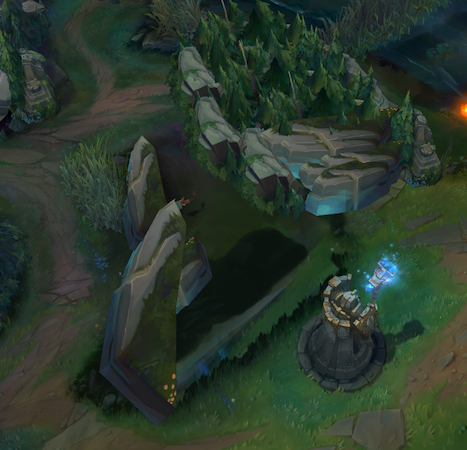
There were holes in the ground plane, heavy z fighting, piles of frogs in the river, and it was cool! We were getting toward map changes that weren’t miserable! That’s always the first step for this kind of change because going from stable and current always leads to some really terrible places at the start.
We unified some walls, pushed them back and forth, cut a hole through that honkin’ big rock in mid lane, and so on.
Then we got to work on the brush more deeply. The value of brush is mostly a product of the value of the walls near them, it controls a lot of fights and vision around terrain and adds a lot of interest. Brush also solves a lot of problems terrain can have on its own. Tackling the minutiae of brush placement and size was a great exercise, but also a minor battle in its own right.
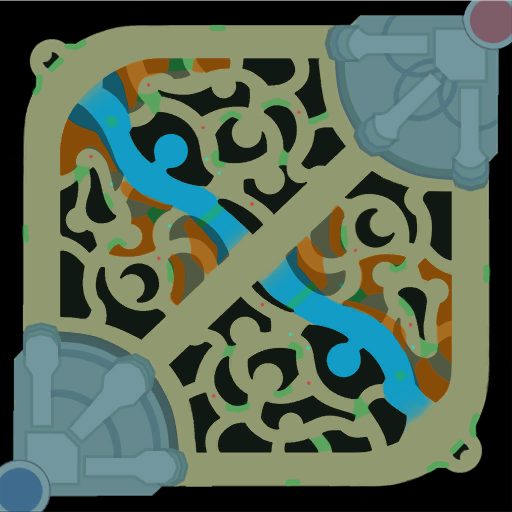
Brush can’t be too far from each other or there’s too much free space for fog of war to creep in the jungle. They can’t be too close or they feel worthless and redundant and crowd out fog entirely. They add texture to corners but also make vision around those spots difficult to interact with. They solved a lot of problems around intersections favoring one side or not being interesting to engage in or having sightlines that felt too clean at certain angles. But it also made us play a little jigsaw puzzle, moving around little strands of grass so that Dragon fights still felt meaningful when contested from bot or top river, or blue or red side, or so that we didn’t have one gigabrush in the ocean map as three different bushes accidentally merged.
There were a lot of changes that were actually pretty promising like tower alcoves, or deep water like you see in Arena, or sets of new plants to the base map—but nothing we were quite comfortable with for this set of changes. Maybe someday.
The map of Summoner’s Rift is a space that’s comfortable, but there are so many cool things we could do with it in the future. We know Summoner's Rift is a special place and we take any changes really seriously, so we hope you find that these ones impact your games in a positive way. Let us know what you think and we'll see you out there!
